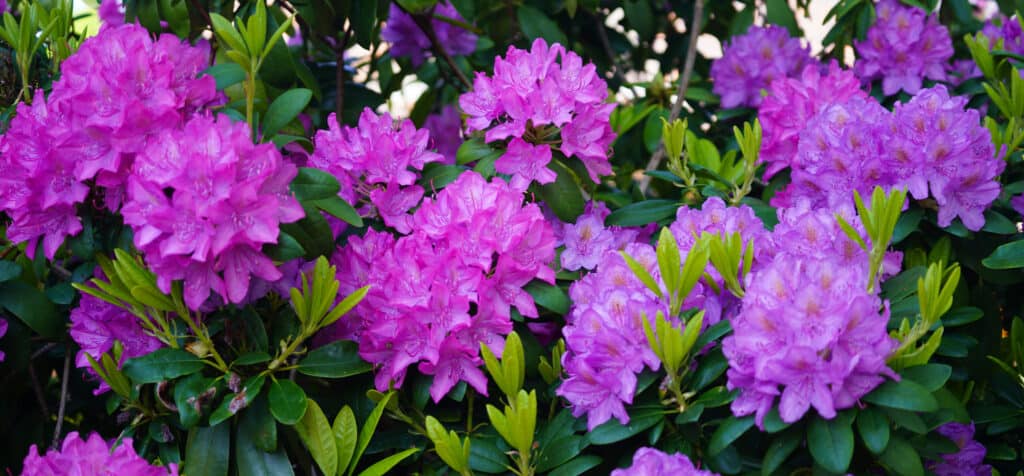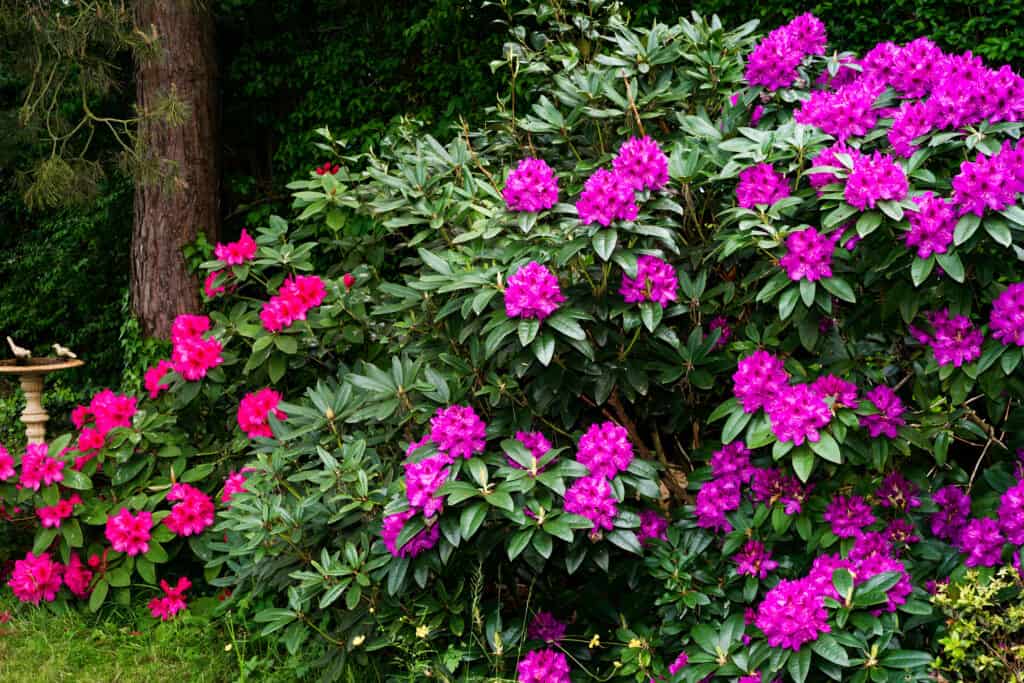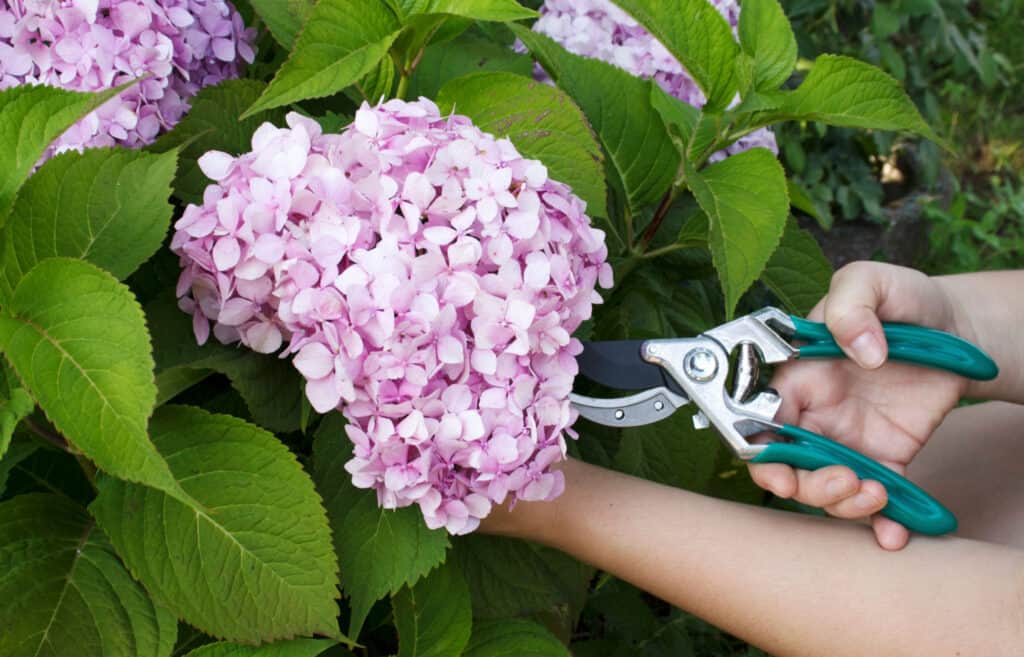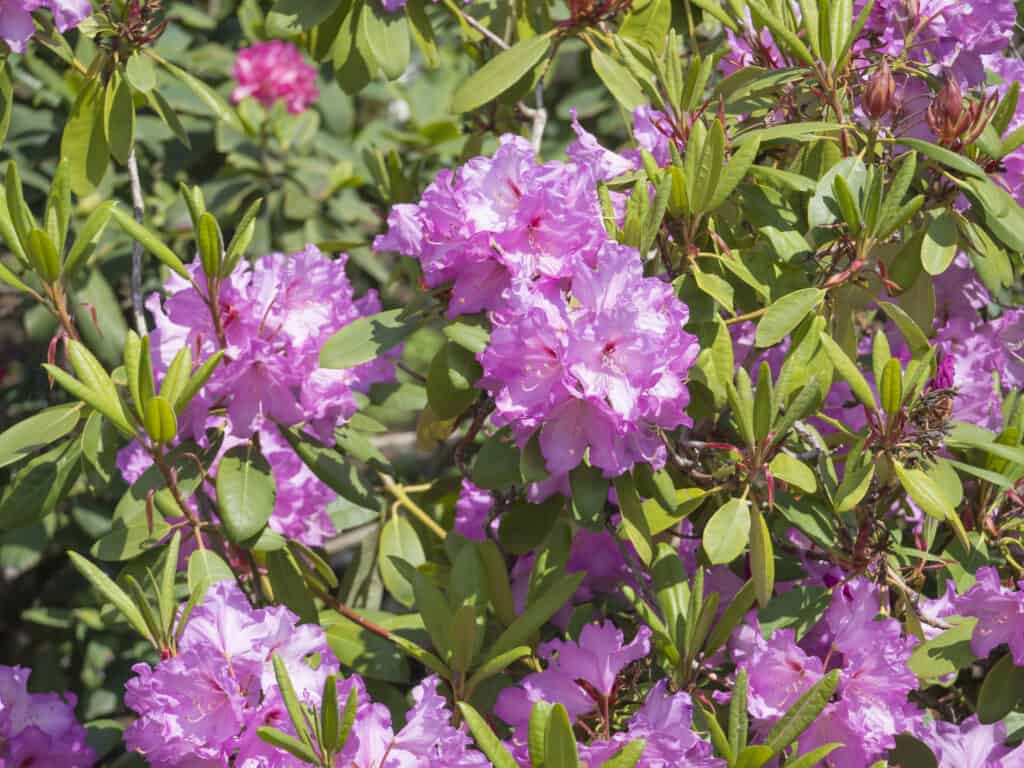Although they’re unrelated, Hydrangea and Rhododendron bushes are similar in so many ways and are super easy to confuse with each other. Unless you really know what their flowers look like, it’s usually quite hard to tell the two apart just by looking, and it doesn’t help that they grow almost exactly the same way!
A big part of this confusion is that Hydrangea and Rhododendron are actually classifications (genera) that each includes hundreds of species. So there isn’t one look of a Hydrangea or Rhododendron that can be compared against the other.
Thankfully, you don’t need to be a botanist to identify a Hydrangea from a Rhododendron. Once you’ve learned about the various, small differences between the two, it becomes clearer how to tell the two apart.
Keep reading to see what makes these stunning flowering bushes different from each other and how to identify them!
Hydrangea vs. Rhododendron at a Glance
| Hydrangea | Rhododendron | |
|---|---|---|
| Species | Hydrangea is a genus that includes many species | Rhododendron is a genus that includes many species |
| Looks | Large bush with green leaves and large clusters of flowers | Large bush or small tree with darker green leaves and large clusters of flowers |
| Flowers | 5 petal flowers that grow in large spherical clusters; color depends on the species and ranges from violet, pale blue, white, or red-orange | Bell-shaped flowers that grow in large clusters, covering the bush; colors depend on species and range from scarlet, bright pink, or yellow |
| Size | Depends on the species, can range from 6 to 15 feet tall | Depends on the species, can range from 8 to 20 feet tall |
| Growing Zones | 5-10, depending on the species | 5-10, depending on the species |
| Growing Needs | Acidic soil, full sun, frequent watering | Acidic soil, full or partial sun, deep waterings |
About Hydrangeas
Although there’s a ton of diversity among the different species of Hydrangeas, they all share fundamental similarities since they’re all related. Most Hydrangea bushes grow in similar growing conditions and have the same blooms, even though the color varies by species.
Hydrangea bushes are native to eastern Asia but can be found all over the U.S. and Europe. Hydrangeas are considered large bushes but can also be pruned and trained into small trees.

flowers are most often a pale blue or violet, although they typically start as white when they first bloom.
©iStock.com/Maryna Andriichenko
About Rhododendrons
It’s a similar story with Rhododendrons– there are tons of species in this genus, creating a big range of flowers and sizes. Azalea is another popular flowering bush that’s also in the Rhododendron genus.
This makes it slightly difficult to compare a Hydrangea with a Rhododendron because you should compare two species directly with each other. Some species of Hydrangea are very similar to some species of Rhododendrons, and others that make Hydrangeas and Rhododendrons seem totally different.
Hydrangea vs. Rhododendron: Appearance
At first glance, Hydrangea and Rhododendron bushes look very similar- they’re both large bushes with huge and brightly colored flowers. They’re both very popular for their amazing flowers, so it’s common that people will see a bush with huge flowers and assume it’s one or the other.
In general, Hydrangea flower clusters are more defined and come above the bush, whereas Rhododendron clusters are just on top of the bush and give it a fluffy look.
Hydrangea and Rhododendron bushes are both considered large shrubs and can grow very tall as well as very wide. However, depending on the way the bushes are pruned, you might see either in the form of a small tree, made into a hedge, or kept short.
This also depends on the species, but generally, Rhododendron leaves are darker green than Hydrangea leaves.

flower clusters are just on top of the bush and give it a fluffy look.
©iStock.com/Wieland Teixeira
Hydrangea vs. Rhododendron: Flowers
Knowing how to identify the flowers of Hydrangeas or Rhododendrons is likely the easiest way to tell these plants apart. Once you get closer and can see the individual flowers, it’s quite clear which is which- regardless of the species!
Both of these bushes bloom with flowers in large clusters that can be easily seen from far away. However, Hydrangea flowers are flat and have 5 petals. The flowers look very delicate and crowd over each other to form a large, 10-inch spherical cluster that sticks out above the crown of the bush.
Rhododendron flowers are bell-shaped or sometimes more trumpet-shaped, but in any case, have much more form than the flat Hydrangea flowers. The flowers have long stigmas that are much more noticeable.
The flowers are all conjoined at the center and bloom outwards, forming large clusters that are closer together than those on Hydrangeas. The clusters of flowers are also a bit flatter than Hydrangea clusters and sit on top of the bush rather than stick out above it.
For both Hydrangeas and Rhododendrons, the color of the flowers depends on the species. However, each type has a range of colors you’ll see.
Hydrangea flowers are most often a pale blue or violet, although they typically start as white when they first bloom. You may also see varieties that are light green, yellow, or reddish orange.
The most popular varieties of Rhododendrons that you’ll often see in landscaping have bright fuschia or scarlet red blooms, but they can also be a deep blue or indigo. In general, Rhododendron flowers tend to be darker in hue than Hydrangea flowers.
If not picked, Hydrangea flowers will dry up when they die and hold their form, even through the winter! While Rhododendron flowers drop when they die, so in the winter the plant is just branches and leaves.
Both Hydrangea and Rhododendron bloom in spring or early summer, the exact month depends on the species and growing conditions.

The most popular varieties of
Rhododendronsthat you’ll often see in landscaping have bright fuschia or scarlet red blooms.
©iStock.com/Jean-Luc Farges
Hydrangea vs. Rhododendron: Size
Both Hydrangeas and Rhododendrons can get very big and are some of the largest landscaping shrubs. Regardless of the species, they’re also both considered very fast growers. Both kinds of shrubs can grow very tall and have a really widespread.
Although, as I mentioned earlier, size isn’t a useful indicator for identifying these plants because they’re usually pruned and very easily trained to take on different shapes.
It’s common for gardeners to prune a Hydrangea or Rhododendron into a small ornamental tree and train it to grow up as opposed to out. It’s also common to plant many of these bushes next to each other to form a long hedge or natural fence.
In general, Hydrangeas and Rhododendrons grow to be 12 to 15 feet tall and 6 to 8 feet wide, but some species of each can grow much taller and larger! Many Rhododendron species can reach 20 feet tall, but not as many Hydrangeas that will grow as big.
Hydrangea vs. Rhododendron: Growing Zones
Hydrangeas and Rhododendrons typically grow in the same USDA Plant Hardiness Zones, although Rhododendrons are hardier than Hydrangeas.
Generally, Hydrangeas grow in Zones 8 to 10, although most do best in Zones 9 and 10. There are a few cold hardy varieties that can better tolerate growing in Zones 6 or 7- some even Zone 5- but these aren’t as common.
Rhododendrons tend to be more cold-hardy than Hydrangeas and prefer Zones 8 and 9, with just a few that can grow in Zone 10 warmth. There are a lot more cold hardy species of Rhododendrons than there are of Hydrangeas, many of which can grow in Zones 5 and 6.

flowers will be more blue or indigo in acidic soil and more purple or rose in more alkaline soil.
©Natallia Ustsinava/Shutterstock.com
Hydrangea vs. Rhododendron: Growing
Hydrangeas and Rhododendrons are both super popular for landscaping and ornamental gardens. Because they both grow so big, neither of them is a good choice as a houseplant and are better grown outdoors.
You can grow a Hydrangea or Rhododendron in a container planter, as long as it’s large enough and has good drainage. There are some species of both types of bush that are miniature and can be grown on patios or balcony gardens.
Hydrangea vs. Rhododendron: Sunlight
Both Hydrangeas and Rhododendrons grow in full to partial sunlight and will suffer if they’re in complete shade. Dappled sunlight is fine as long as it’s not for the whole day and the bushes can receive direct sun for a few hours.
Hydrangeas do better in partial shade and appreciate morning sun with afternoon shade. While Rhododendrons can handle full sun better than Hydrangeas, which can easily get sunburnt from intense sunlight.
Hydrangea vs. Rhododendron: Water Needs
Hydrangeas and Rhododendrons both have moderate water needs- they aren’t very drought tolerant but they don’t drink tons of water.
Hydrangeas tend to need water more frequently and do best when watered about one inch once a week. They’re also very responsive: the leaves droop when the plant is too dry but perk back up once watered.
Rhododendrons are a little less needy and can be watered once every other week. Rhododendrons prefer deep watering, like you get from a drip irrigation system that lets water soak into the soil. However, if you have frequent rains, you don’t need to water unless you’re having a dry spell.
For both Hydrangeas and Rhododendrons, you don’t need to water in the winter, while the plant is dormant.
Hydrangea vs. Rhododendron: Soil Type
Both plants need moist, well-draining soil that retains moisture but never gets soggy or traps water in. They’re both very vulnerable to root rot, so excess water sitting in the soil will be a big problem.
Neither Hydrangeas nor Rhododendrons are drought-tolerant, so the soil should never become too dry. Adding a layer of mulch around the top of the soil will help keep moisture in.
Planting Hydrangeas and Rhododendrons in nutrient-rich soil ensures that they have enough nutrients to grow with and you won’t need to fertilize.
Hydrangea vs. Rhododendron: Soil pH
Hydrangeas prefer slightly acidic or acidic soil, ranging from 5.0 to 5.5 pH. Hydrangeas have greater adaptability to soil than Rhododendrons and can grow in less acidic soils.
Interestingly, the acidity of the soil affects the color of the blooms! The flowers will be more blue or indigo in acidic soil and more purple or rose in more alkaline soil. Although, again, this varies according to the species.
Rhododendron flowers don’t change colors with changes in acidity, but the plant will just grow slower and be less healthy if the soil isn’t acidic enough.

Many
Rhododendronspecies can reach 20 feet tall.
©iStock.com/Kristyna Sindelkova
Hydrangea vs. Rhododendron: Pests or Diseases
Thankfully, Hydrangeas and Rhododendrons are both fairly disease free and don’t have any common pests to look out for. As with most plants, you may find aphids or spider mites on the bushes, but this is rare and typically only happens if the bush is already sick.
Hydrangeas tend to be more susceptible to powdery mildew, but this is likely because they grow in warmer climates.
The main concern is root rot- which can be avoided with good soil drainage- but either bush can be affected by bacterial wilt, flower blight, or leaf spots.
Hydrangeas and Rhododendrons Are Just the Beginning!
Now that you know the main differences between Hydrangea and Rhododendron bushes, you can start to compare specific species of each to find which one(s) would be best for your garden!
There are seriously hundreds of species of both Hydrangea and Rhododendrons, so the specifics about growing and their looks will depend on the variety you’re working with. Picking a variety will help you determine if it can grow in your Zone and if it will go well in your space.
Up Next
- Rhododendron vs Azalea: Is There a Difference?
- Pee Gee Hydrangea vs. Limelight Hydrangea: What Are The Differences?
- Hydrangea Seeds: Experiment With This Popular Shrub!
The photo featured at the top of this post is © iStock.com/phanasitti
Sources
- SF Gate / Accessed November 3, 2022
- Bean Growing / Accessed November 3, 2022
- Garden Guides / Accessed November 3, 2022
- Oregon State / Accessed November 3, 2022
Thank you for reading! Have some feedback for us? Contact the AZ Animals editorial team.







